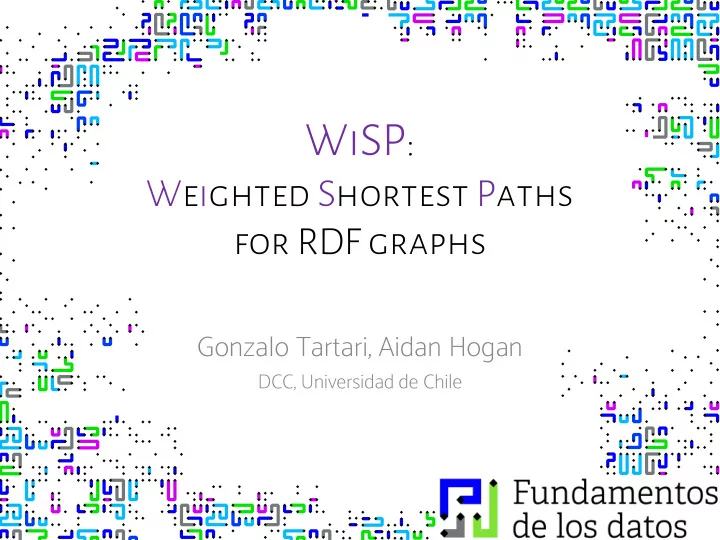

WiSP : Weighted Shortest Paths for RDF graphs Gonzalo Tartari, Aidan Hogan DCC, Universidad de Chile
"Interesting" Paths = Shortest Paths?
"Interesting" Paths ≠ Shortest Paths!
(Many of the) Existing Approaches Enumerate Score Order/Filter Output Paths Paths Paths
(Many of the) Existing Approaches Enumerate Enumerate Score Order/Filter Output Paths Paths Paths Paths
(Many of the) Existing Approaches Enumerate Score Order/Filter Output Paths Paths Paths
Our Approach: Weight Graphs
Wei eigh ghti ting ng gr graphs hs: No Node des
Node Weights: Length (Baseline) ...
Node Weights: Degree ...
Node Weights: PageRank ...
Aside: PageRank / directed graph used ...
Wei eigh ghti ting ng gr graphs hs: Ed Edge ges
Weighting with only nodes
Weighting with only nodes
Edge Weights: Frequency
Wei eigh ghti ting ng gr graphs hs: No Node des + E s + Edg dges es
Node + Edge Weights: Degree + Frequency ...
Node + Edge Weights: PageRank + Frequency ...
Node + Edge Weights: PageRank + Frequency ...
Node + Edge Weights: [0,1] Normalisation ...
Hy Hybrid d No Node de Wei eigh ghts ts
Node Weights: PageRank Visiting one high-centrality node = Visiting thousands of low-centrality nodes ...
Hybrid Node Weights: PageRank + Length ...
Imp mplem emen entat tation on
Weighted Shortest-Path Implementation • Dijsktra's algorithm: – Worst case: Image source: https://github.com/aakash1104/Graph-Algorithms
Ex Exper erimen ments ts
Questions • Performance: – How are the runtimes? – How is the scalability? • Weighting schemes: – How similar are paths for different weightings? – Does weighting help find interesting paths? – Which weighting finds the most interesting paths?
Dataset: Wikidata • Truthy dump: 2017-06-07 – 25 million nodes ( -IRIs only) – 90 million edges
Dataset: Wikidata Slices
Machine • 2 x Intel Xeon Quad Core @1.9GHz • 32 GB of RAM
Weighting Schemes • Node – Degree ( ) – PageRank ( ) – Length ( ) • Node + Edge – Degree + Edge Frequency ( ) – PageRank + Edge Frequency ( ) • Hybrid Node + Edge – Degree + Length + Edge Frequency ( ) – PageRank + Length + Edge Frequency ( )
Pe Perfo forma manc nce
Queries (Node pairs) • Queries: 100 node pairs randomly sampled – From smallest slice ( code < ) – From each slice independently • Task: Return one (best) path
Performance Results (Full Dataset)
Performance Results ( | Various Scales)
Comp mpariso ison n of w f wei eigh ghti ting ng sc sche heme mes
Comparison of path length (full dataset)
How many pairs give the same path? (full dataset)
Us User er Stu tudy dy
Queries: Same type
Queries: Different types
User study • 10 students • 1.6 M dataset • Shown all paths for one query together • Scores: 1 (very poor) - 7 (very good) • 79 complete evaluations – 4 evaluations per query (node pair) – 553 scores
Lowest-rated path mean score 1.25 ( {1,1,1,2} )
Highest-rated path mean score 6.0 ( {5,7} )
Inter-rater agreement • Kendall's τ correlation (ordinal scales) – τ = 0.201 – Slight, positive agreement • Two sets of results – All • τ = 0.201, 20 queries, 79 evaluations – Concordant • Queries with positive τ correlation only • τ = 0.552, 8 queries, 27 evaluations
User study: Comparison of weightings
http://wisp.dcc.uchile.cl Dem emo
WiSP Demo ?
Conc nclus lusion ons
Conclusions • Performance: – How are the runtimes? • A few seconds (1.6 m) to a few minutes (full dataset) – How is the scalability? • Linear (roughly) • Weighting schemes: – How similar are paths for different weightings? | similar; others not so much • – Does weighting help find interesting paths? • Yes! – Which weighting finds the most interesting paths? • No clear winner ( best in most cases)
Future work • Top- k queries • Explore more weightings • Normalisation / combinations • Performance? (Parallelism? Approximation?) • ¡¡¡Evaluation!!!
Recommend
More recommend